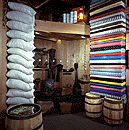Grand Hall tour
Kwakwaka'wakw Exhibit
(Central Coast House - interior)The theme of this exhibit is the Kwakwaka'wakw potlatch. A potlatch is an occasion at which guests, who are not part of the social group most closely related to the hosts, are called to witness an event important to the host, such as the building of a house, the inheritance of a chief's title, the marriage of a child, or the erection of a totem pole. The term potlatch, a Chinook jargon word meaning "to give" or "a gift", refers specifically to the distribution of gifts made by the host to the guests to acknowledge their role as honoured witnesses.
The exhibit represents three time periods: 1890-1910, when the original house was standing in Alert Bay and when many of the masks and feast dishes now in the Museum's collection were made and used; the 1930s, when the potlatch was actively suppressed by law but maintained quietly by families; and the present day.
 In the first section, feast dishes, a carved figure showing the importance
of a chief, and other objects associated with the turn-of-the-century
potlatch are presented. These include bolts of cloth, brass oar locks,
lanterns, sacks of flour, Hudson's Bay blankets, canoes and other goods
given to guests at a potlatch at this time. Opposite are masks from the
same period. If still in use, masks are shown only when they are worn
by dancers. At other times they are kept in seclusion, out of respect
for their power. In keeping with this custom, the masks in the exhibit
are shown behind a dance screen made of wooden planks in the old style.
In the first section, feast dishes, a carved figure showing the importance
of a chief, and other objects associated with the turn-of-the-century
potlatch are presented. These include bolts of cloth, brass oar locks,
lanterns, sacks of flour, Hudson's Bay blankets, canoes and other goods
given to guests at a potlatch at this time. Opposite are masks from the
same period. If still in use, masks are shown only when they are worn
by dancers. At other times they are kept in seclusion, out of respect
for their power. In keeping with this custom, the masks in the exhibit
are shown behind a dance screen made of wooden planks in the old style.
 The 1930s section shows a room in the house of a Kwakwaka'wakw family as
it was in 1937. The house post in the room stood in the family's home for
many years. Carved in 1925 by Kwakwaka'wakw artist Charlie James, it was
made in memory of a house post on Village Island which had been destroyed
in a fire.
The 1930s section shows a room in the house of a Kwakwaka'wakw family as
it was in 1937. The house post in the room stood in the family's home for
many years. Carved in 1925 by Kwakwaka'wakw artist Charlie James, it was
made in memory of a house post on Village Island which had been destroyed
in a fire.
 In the third section, a six-projector slide show presents the history and
contemporary meaning of the potlatch. The final section shows potlatch
gifts of the kind given to guests in the 1990s. The principles are the
same as they were a century ago: suitable gifts are food, baskets and
other containers, and textiles (such as blankets and tea towels). The form
of the gifts is contemporary, however.
In the third section, a six-projector slide show presents the history and
contemporary meaning of the potlatch. The final section shows potlatch
gifts of the kind given to guests in the 1990s. The principles are the
same as they were a century ago: suitable gifts are food, baskets and
other containers, and textiles (such as blankets and tea towels). The form
of the gifts is contemporary, however.
This exhibit was made possible through generous gifts from Mr. and Mrs. Eric W. Padgham and Miss Mabel LeCouvie.

